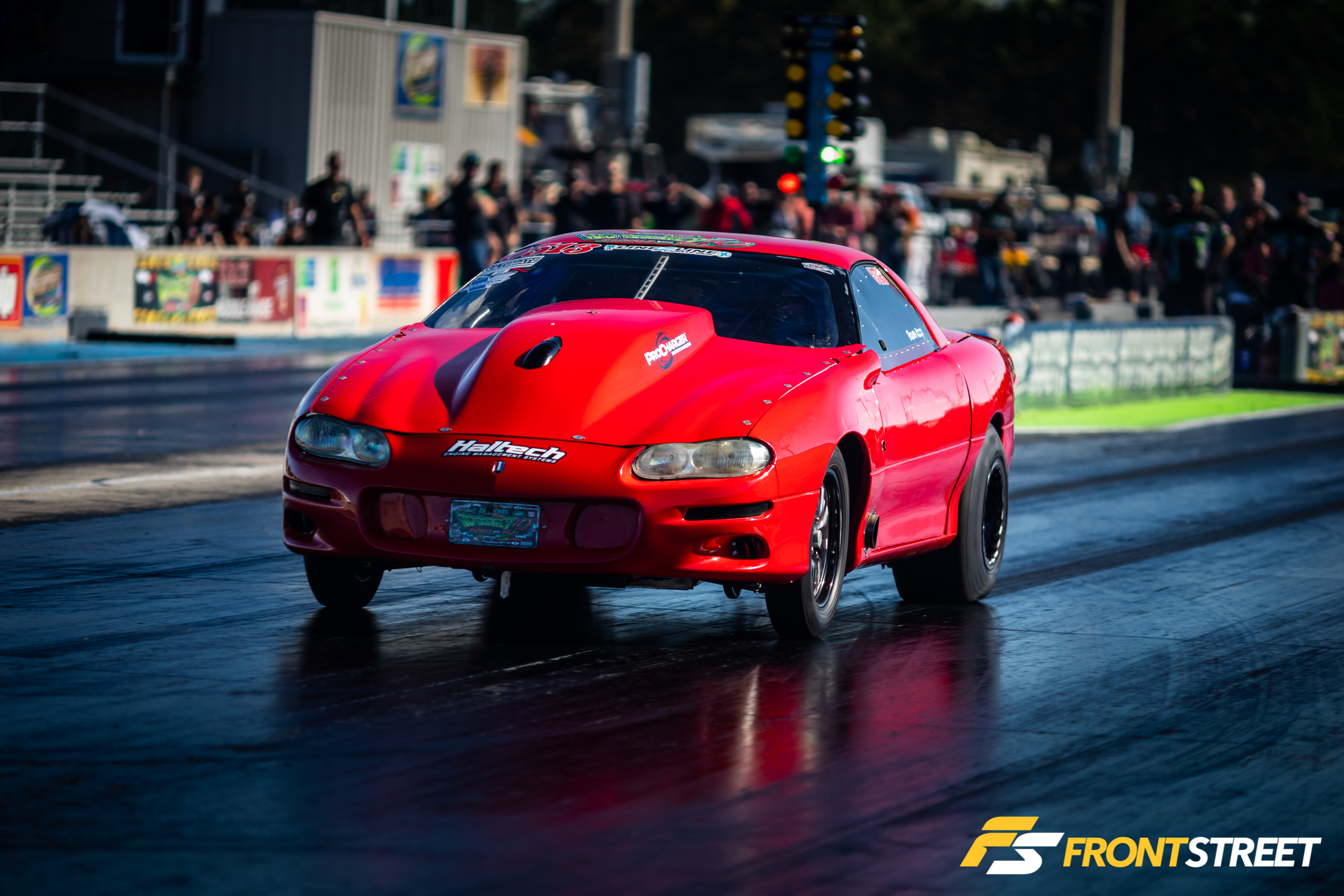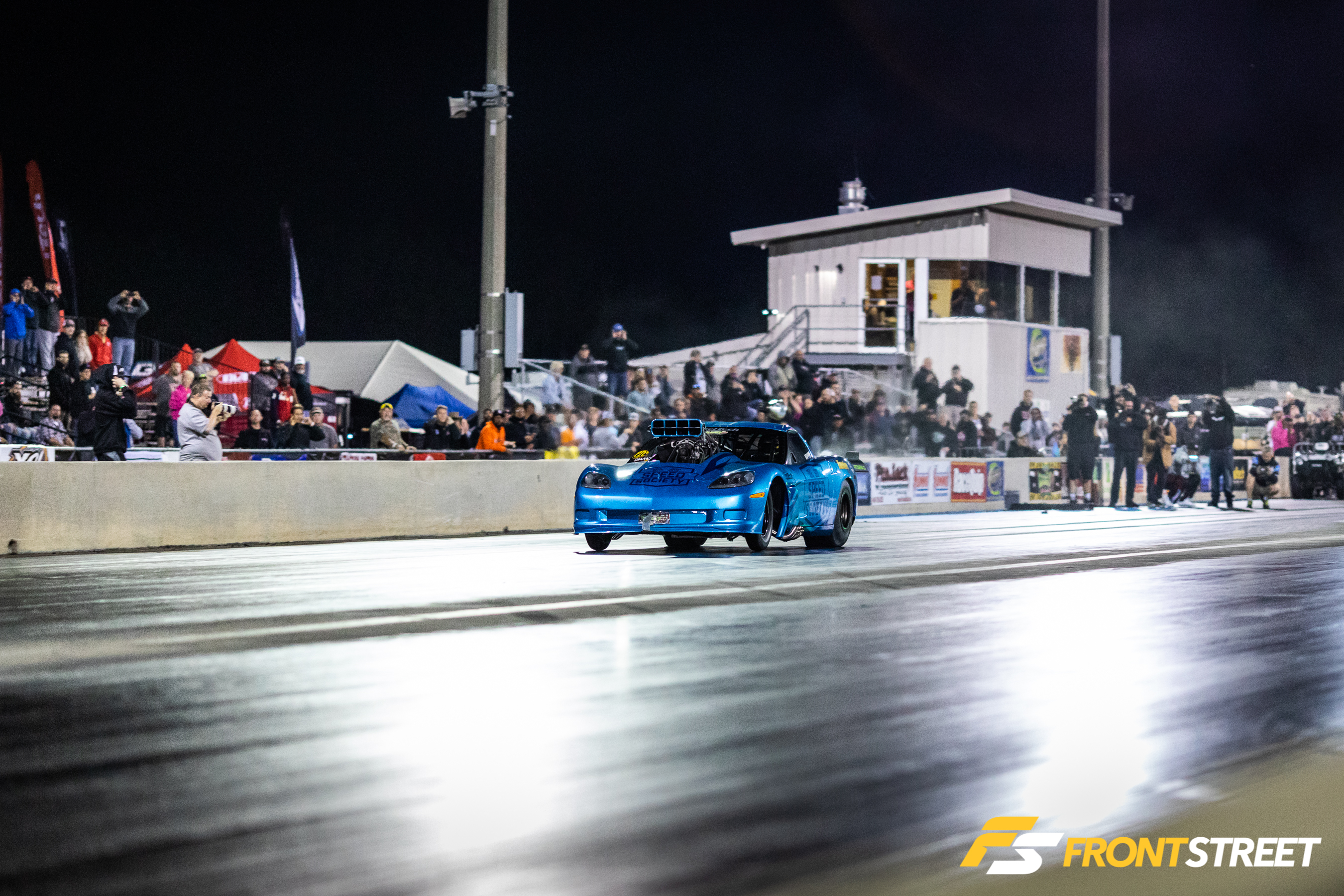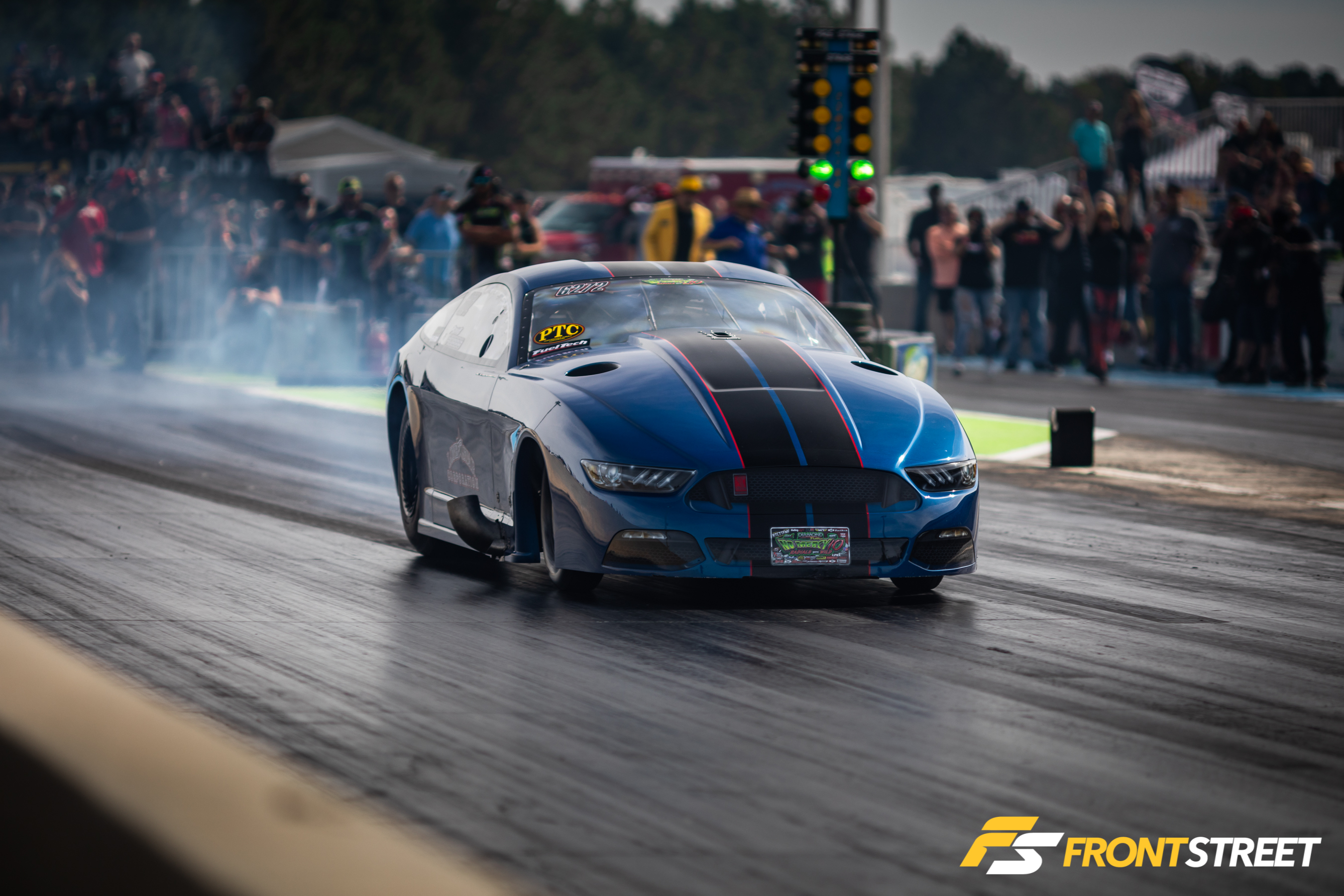I don’t know how it’s taken me ten years to get to one of Donald Long’s No Mercy races held at South Georgia Motor Sports Park (SGMP), but it has, and after the events of this past weekend, I don’t think I’ll miss another one as long as Duck X Productions is promoting these events. My trip to DXP’s Sweet 16 2.0 earlier this year solidified my interest in drag radial racing, a love that has taken several years to come to fruition. As radial tire-equipped cars have taken the drag racing world by storm over the last decade, I’ve watched with deepening enthusiasm as the racers involved in these competitions have recorded unimaginable pass after unimaginable pass on the eighth-mile surface of SGMP, sometimes taking literal flight from the racing surface in their pursuit of performance.
After Sweet 16 2.0 was complete, I immediately booked a room for No Mercy (and have already booked for Lights Out 11 in February), so I think it’s safe to say that I’m hooked. Although it didn’t go exactly to plan as Saturday rained out and some elimination rounds were contested Friday, then finished up on Sunday, it was still a killer event by all accounts.
After talking with some of my photographer buddies leading up to No Mercy week, though, I was a little nervous about what to expect. After all, they call it Duck Week for a reason—the event takes place over what amounts to an entire week for some people, who use their vacation time to attend this racetrack in the middle of nowhere—for an event that can, quite simply, make a racer’s career complete.




Case in point: when I was standing at the very top end of the track on Sunday evening as the finals ran, Ultra Street racer Joel Greathouse—who seems to be in the final round every time he attends an event—was dejected as he lamented his loss to Brian Keep, who beat him handily on the starting line and never relinquished the lead. He said, quite simply, “I just want to sweep one of these, one year.” Greathouse won at Lights Out 10 in February and was oh-so-close here at No Mercy X, but Keep unrolled a .001 reaction time to bring his hopes to a close.
Keep was on a tear all weekend long, as he knocked down a .001 reaction time in the quarterfinal and another .009 in the semi on his way to meet up with Greathouse. He was simply ecstatic with the win, as a recent change to dampers from Menscer Motorsports made a big difference in his program, and he outpowered Greathouse to the finish line to top off his killer weekend. One thing that made it so special? He returned the favor to Greathouse, as Keep was on the losing side of the final round back in February. Sweet redemption for Keep.





Stevie “Fast” Jackson needs no introduction… he is an incredible driver no matter what chassis and powerplant are underneath him. Just before he showed up at No Mercy, he wrapped up the NHRA Pro Mod title with back-to-back wins at Richmond and Charlotte, earning a cool $50k in the process for his efforts. On fire behind the wheel, he proceeded to run the table in Radial Vs. The World at No Mercy, qualifying at the top of the field of 57 cars with a 3.60 at 212 mph.
Once eliminations started, Jackson relied on the talents of Billy Stocklin, Phil Shuler, and the rest of the Bahrain 1 team to propel Shadow 2.0 into the winner’s circle by eliminating the real-deal steel ’69 Camaro of fan-favorite Tim Slavens in the final round. For a week of work at No Mercy, Jackson collected another $50k. Let’s not forget the massive driveline failure he and his team had to repair on Thursday to play in the show and the fact that Jackson was playing tuner for four other cars on the property, including Marcus Birt and Chad Henderson among others. It was a Herculean effort by the most talented racer I’ve ever met. In my opinion, it’s only a matter of time before he replaces John Force as the NHRA’s biggest draw—the guy is that big of a deal.




Another potential big story from the weekend was the plan of Alex Laughlin to race, not only in Radial Vs. the World, but also NHRA Pro Stock. Two classes, two events, two states, one driver. He planned to qualify in RvW, then fly to Texas to qualify in Pro Stock, then come back to race in RvW, before flying back to Texas to finish out his weekend in Pro Stock. Laughlin made it to the third round of eliminations on Friday before getting outrun by eventual semifinalist Timmy Meissner, which simplified his weekend and allowed him to get on the plane to Texas, although it was two rounds sooner than he would have liked.



Just before No Mercy, Ronnie Hobbs picked up this 2017 Mustang RvW car formerly owned by Daniel Pharris, did some testing in Florida, then made the trek to SGMP to try his luck behind the wheel against some of the stiffest competition in the world. Despite not making the field of 32 RvW cars, Hobbs entered the RvW Gamblers race, which required a $200 entry fee in a winner-take-all format. With 12 cars entered—and names like Jeff Miller, Paolo Giust, and Marcus Birt in the field—it was quite impressive to see Ronnie power to the winner’s circle over Jeff Miller in the final round. It may not have been the big show, but I guarantee you that Ronnie Hobbs and his family were just as excited to see that win light in the final round. Their joy when they came to collect Ronnie at the end of the track was unmistakable. They could be proud of this win in their first weekend at the track with a new-to-them car.




Bruce Maichle has had his hands full all season, with crew-chief duties on Rob Goss’ X275 Challenger and his own 2002 Pontiac Firebird, piloted by friend Mike Cerminaro, keeping him busy. Both cars run ProCharger superchargers, with a Gen III Hemi-style engine under Goss’ hood and an LS-based engine under the hood of the Firebird. Heading into the event, I fully expected Goss to go to the final round in X275, but he had made changes leading into the race that ended up hindering him during qualifying. He went into eliminations somewhat blind, and although he won the first two rounds of competition on Friday, come Sunday, the track surface was completely different, and he didn’t have the necessary data to capture the win.
But teammate Cerminaro had no such problems. He ran the table against the toughest X275 racers in the world, despite not having anything close to the quickest car in the class. Cerminaro qualified 13th of 32 cars, then relied on his consistency to capture the team’s first-ever X275 win. Who did he beat to do it? Just some of the best X275 racers on the planet: Rich Bruder, Tim Dutton, Shane Fisher, Ducky Johnson, and Charles Hull, who has been in the final round of nearly every race he’s attended all year. It was an extremely impressive win for the Delaware-based Cerminaro.



If you had told me before the event that an X275 racer would take out all of the teams in Pro 275, and do it without ever running quicker than 4.377, I’d have told you to keep on dreaming. But that’s exactly what J.D. Campbell did. He beat out the best of the class by doing the one thing that can guarantee wins on race day: run consistently, no matter the conditions. Despite David Pearson rocking the clocks with two passes in the 3.90s from his Fox body Mustang, as eliminations progressed, many of the racers in the class just couldn’t figure out the green track surface after Saturday’s rain, opening the door for the Texas-based Campbell to run like a bracket car and take home the Pro 275 win.




All season long, Jim Howe, Jr. has been virtually unstoppable in his blown Limited Drag Radial “Honky Kong” Camaro. He’s been knocking on the door of the 3s on several occasions, and won every race he’s entered. Which means he’s won every round of racing, all season long, in the process wrapping up the LDR championship. But then he met Eddie Harrison in the final round at No Mercy and ran into an ignition issue at the same time. Despite leaving the starting line first, Big Jim had to sit in the seat and watch Harrison drive around him for the win with a 4.13 to Howe’s slowing 4.20. I was at the top end as the pair arrived at the turnoff and unbuckled, and it was so refreshing to see how humble Jim was in defeat.


Including the performances of Harrison and Howe, Jr., Limited Drag Radial was full of interesting action across the board. I was impressed to see that Justin “Red” Martin made it to the track with his Nova. While competing at a local event at the beginning of September, Martin had an accident at the track that ate the whole front end and both rear quarters on his 1972 Nova. Not to be deterred, he enlisted his entire team and the help of many companies: Strobel Race Cars, Motion Raceworks, Harrell Engine & Dyno, Garrett Turbo, Weld Racing, M&M Transmissions, Menscer Motorsports, MacFab Beadlocks, TBM Brakes, Unlimited Fiberglass, and Holley EFI in the rebuild. Somehow, they came together to get the engine rebuilt, the whole car revamped, and at the track on Wednesday for No Mercy. Although the Nova wasn’t pretty—far from it—Martin qualified 17th of 32 cars and went to the second round before falling to Matt Bell. The impressive effort served to reinforce my impression of Martin’s work ethic.


Let’s talk about Matt Bell for a moment, too. Matt and I have been friends for a long time, and it’s been amazing to watch his LDR program come together over the last season or so. Bell’s Mustang has been a frontrunner in the class all year long, and to see him light the scoreboard with a 4.047 at 190 mph was awesome. I do not doubt that the 3-second barrier in LDR is going to fall at Lights Out 11 in February. No doubt whatsoever. And I’m going to be there to see it.



Earlier this year I had the opportunity to make the acquaintance of Pete Harrell of Harrell Engine & Dyno down in North Carolina, and as I’ve spent more time attending these Outlaw-style races this year than I ever have before, one constant seems to keep appearing at every event: HED stickers on so many of the front-running cars. HED’s slogan? “Real good at doin’ stuff.”
Why is this significant? Because Mark Rogers—who two weeks before No Mercy didn’t even have an engine in his Mustang—went out and decimated the Ultra Street record during qualifying, lighting the board with a 4.538 at nearly 155 mph.
Rogers had pushed the engine past its limit at the Shakedown Nationals, so Harrell put out the call for help, and the team procured a new engine block from one source and a new crankshaft from fellow engine builder Tim Eichhorn at MPR Racing Engines down in Florida. Harrell recreated the engine, the team installed it back into the car and was rewarded with the Ultra Street record-setting pass. Unfortunately, the team was battling some boost control issues, and Rogers fell to Tony Orts in the second round. Once these guys get this car sorted out for good, Rogers will be a contender to end up in the winner’s circle every single time out. It’s insane to see this car running so quickly with only 283 cubic inches under the hood.



I also had the pleasure of meeting Jason Terrell and Brad Schnieders of Tin Soldier Race Cars, and we spent a fair amount of time discussing their reasoning for building a car to race in DXP235. I shot a full feature on the car, which you’ll see over the winter right here on Front Street. The story is somewhat surprising, and I’ll leave you with the fact that they built a competitive car for the paltry sum of right around $30,000, or less than what most new cars sell for today. Of course, it uses a stock LS 6.0 block, crank, and cylinder heads, with choice components in all of the right places, but the sum of the parts means 5-teen elapsed times and a fun season of racing in DXP325.


Other class winners included Martin Connelley in DXP235, Roger Holder in the Carolina No Time Shootout, Jackson Henderson in 6.0 Index, and Michael Strickland in Open Comp.
I could continue writing about all of the great discussions I had at No Mercy X and talk about all of the new people I met, but I’d like to leave you with a single thought that kept running through my head all weekend. Ever since I became a drag racing journalist back in 2002, I’ve always believed that people are the greatest part of this sport.
Witnessing the winner/runner-up interactions at the top end during No Mercy only served to cement that feeling. Despite the disappointment, every runner-up offered a hearty congratulatory handshake to the racer who captured the win light. It was refreshing in a time of polarization among many different facets of the hustle and bustle of daily life as it is in 2019. People are what make life worth living, but racing takes a close second for me. I can’t wait for Lights Out 11 in February.















































































































































